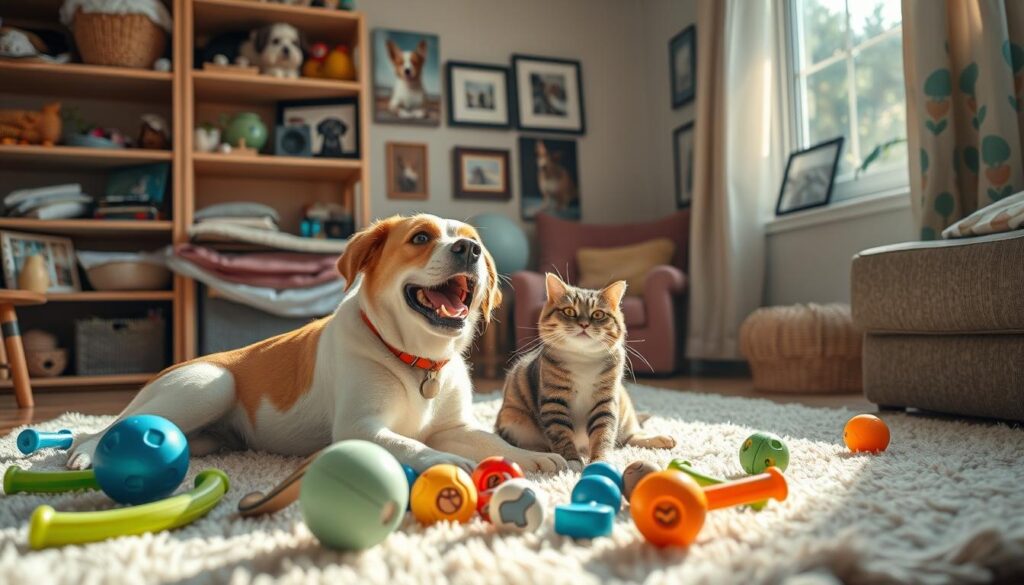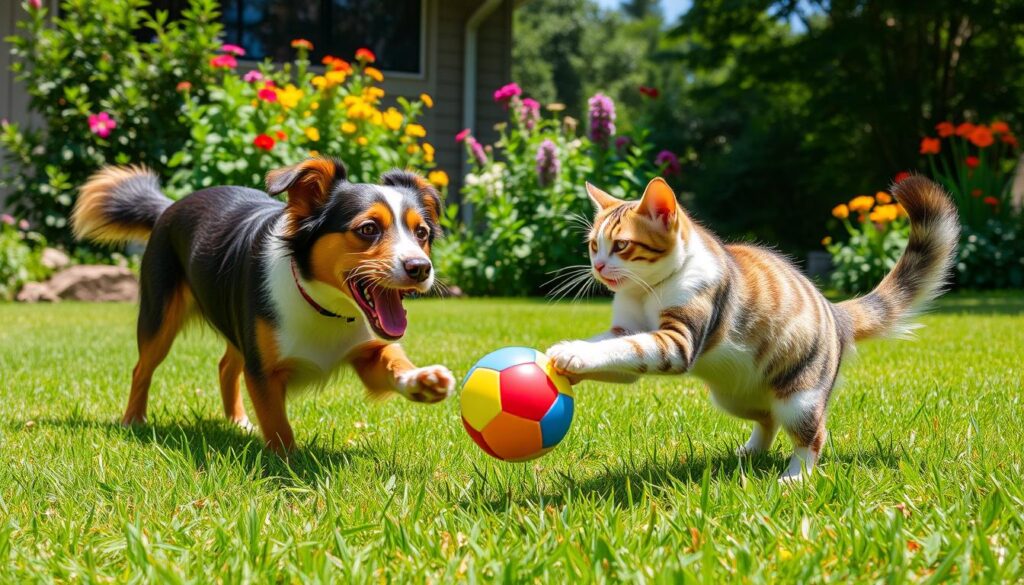Creating a strong bond with your pet is key for their happiness and yours. Whether you’ve just brought home a new pet or want to get closer to your current one, these eight tips will help. They’ll help you build trust and create a strong connection with your animal friend.

Key Takeaways
- Understand the importance of building trust with your pet for their emotional and behavioral well-being.
- Learn to recognize and respond to your pet’s body language and stress signals.
- Create a safe, comfortable, and structured environment to help your pet feel secure.
- Engage in positive, interactive playtime to strengthen your bond.
- Establish training through rewards-based methods to reinforce good behavior.
Understanding the Importance of Pet Trust
Building a strong bond with your pet is key for their happiness and your relationship’s success. When your pet trusts you, it’s more than just following commands. It’s a deep connection that enriches both your lives. (Pet Trust)
Emotional Benefits for You and Your Pet
A bond of trust brings establishment of trust with pets, making your pet feel safe and comfortable. This can reduce stress and increase happiness for both of you. Pets that trust you are more likely to show affection and respond well to humane training methods. (Pet Trust)
The Impact on Your Pet’s Behavior
When your pet trusts you, they act better and listen to you more. Pet psychology shows that trusting pets are less likely to have behavioral issues. They also adapt better to new places and situations. (Pet Trust)
Long-term Relationship Enhancements
Trust is the base for a lasting, happy relationship with your pet. Pets that trust you stay loyal and loving, making your bond strong and rewarding for years. (Pet Trust)
“Earning the trust of an animal is one of the most rewarding experiences a pet owner can have. It’s a testament to the power of patience, understanding, and genuine care.” (Pet Trust)
Assessing Your Pet’s Needs
Understanding your pet’s needs is key to a strong bond and trust. Recognizing their body language and stress signals helps. This way, you can make sure they feel safe, comfortable, and confident. (Pet Trust)
Recognizing Body Language
Watching your pet’s body language is crucial. Look for signs of relaxation like a loose, wagging tail or soft, blinking eyes. On the other hand, tense muscles, a tucked tail, or avoiding eye contact might mean they’re uncomfortable or anxious. (Pet Trust)
Identifying Stress Signals
- Excessive panting or drooling
- Trembling or shaking
- Ears pinned back
- Refusal to interact or engage
Spotting these stress signals helps you know when your pet is feeling overwhelmed. This lets you adjust your approach and offer the support they need. (Pet Trust)
Tailoring Care Strategies
Every pet is different, with their own personality and preferences. By observing their unique needs, you can create care strategies that help with pet socialization, pet anxiety reduction, and building confidence. This might mean adjusting the pace of interactions, introducing new experiences slowly, or creating a safe, comfortable space.
| Behavior | Possible Cause | Suggested Response |
|---|---|---|
| Cowering or hiding | Feeling overwhelmed or anxious | Provide a quiet, calm space and gradually introduce new situations |
| Excessive barking or vocalizations | Seeking attention or expressing excitement | Redirect with positive reinforcement and engage in interactive playtime |
| Refusing treats or food | Stress or discomfort | Offer familiar, comforting items and gradually reintroduce new foods |
By tailoring your approach to your pet’s unique needs, you can strengthen your bond. This also helps reduce anxiety and build their confidence over time. (Pet Trust)

Creating a Safe and Comfortable Environment
Building trust with your pet begins with a safe and comfy home. Understanding what they need, taking safety steps, and setting a routine helps. This way, your pet feels secure and happy. (Pet Trust)
Ideal Living Spaces
Every pet is different, so their living space should match their needs. Whether it’s a cat, dog, bird, or reptile, here’s what to consider:
- Make sure there’s enough room for them to move and explore, based on their size and energy level.
- Provide cozy spots like soft beds, perches, or hiding spots to make them feel safe.
- Add familiar smells and textures to help them feel comfortable in their new home.
- Give them toys and things to do to keep their minds and bodies active.
Safety Precautions
Keeping your pet safe is crucial for trust and bonding. Here are some steps to ensure their safety:
- Make sure your home is pet-proofed to keep them away from dangers like small items, wires, or harmful substances.
- Use pet-safe doors, windows, and gates to keep them out of risky areas.
- Check their living space often to spot and fix any dangers.
Establishing a Routine
Consistency is key to trust with your pet. A daily routine helps them feel secure and happy. Here’s how to create one:
- Stick to a regular schedule for meals, playtime, and rest.
- Make slow changes to their routine to avoid upsetting them.
- Use treats, hugs, and praise to make the routine positive.
By making a safe, comfy, and predictable home, you start building trust and a strong bond. This improves their happiness and helps with training.
Engaging in Interactive Playtime
Playtime is more than just fun for your pet. It’s key to building trust and a strong bond with them. By playing together, you use positive reinforcement techniques to deepen your connection. This also boosts your pet’s happiness and well-being. (Pet Trust)
Choosing the Right Toys
Picking the right toys for your pet is vital. Think about their pet psychology and what they like. Choose toys that challenge their senses and encourage natural behaviors. These can help build trust and confidence. (Pet Trust)
Activities for Different Species
- Dogs love interactive games like fetch, tug-of-war, and puzzle toys. These activities tap into their hunting and exploration instincts.
- Cats enjoy play that lets them stalk, pounce, and scratch. Wand toys and scratching posts are perfect for this.
- Small mammals like rabbits and guinea pigs love to chase, dig, and burrow. These activities are great for them.
Incorporating Training into Play
Adding positive reinforcement techniques to playtime is very effective. Rewarding your pet for good behavior during play strengthens your bond. It also makes them more obedient and well-rounded. (Pet Trust)

“Interactive playtime is not just about keeping your pet entertained – it’s a crucial component in building trust and strengthening the bond between you and your furry companion.” (Pet Trust)
Establishing Training in a Positive Manner
Training your pet should be a positive experience. It helps build trust and strengthens your bond. Using humane methods makes learning fun for both you and your pet. It also reduces anxiety and promotes socialization. (Pet Trust)
Benefits of Positive Reinforcement
Positive reinforcement is a great tool for training. It rewards good behavior with treats, praise, or play. This encourages your pet to do it again, creating a positive bond. It also lowers anxiety, as your pet sees training as a good thing. (Pet Trust)
Setting Realistic Goals
Setting goals that fit your pet’s abilities is key. Don’t overwhelm them with too many commands. Start with one or two behaviors at a time. This keeps them interested and helps them learn well. (Pet Trust)
Consistency is Key
Consistency is vital in training. Use the same commands, rewards, and techniques every time. This reinforces good behavior and lays a strong foundation for learning. It also promotes socialization and reduces anxiety, making your relationship with your pet better. (Pet Trust)
“Positive reinforcement is the most effective way to train a pet, as it builds trust and creates a positive association between the desired behavior and the reward.” (Pet Trust)
Effective Communication with Your Pet
Building a strong bond with your furry friend is more than just physical touch. It’s also about understanding each other through communication. By knowing how to read your pet’s sounds and body language, you can create a closer connection. This helps in building confidence in pets and deepens the pet bonding experience. (Pet Trust)
Understanding Vocalizations
Pets talk to us in many ways, like barks, meows, purrs, and whines. Learning to understand these sounds helps us know how they feel and what they need. Paying attention to the sound’s pitch, volume, and rhythm can teach us a lot about their animal behavior training.
Utilizing Body Language
Watching your pet’s body language is key to good communication. Things like tail position, ear placement, eye contact, and posture tell us a lot about their mood and plans. By paying attention to these signs, we can better meet their needs and grow our bond.
Building a Unique Communication Style
- Try different tones, words, and gestures to see what works best for your pet.
- Use training in your daily life to encourage good behavior and strengthen your bond.
- Play together and share activities to create a special language and understanding.
Good communication is the heart of a fulfilling pet bonding relationship. By customizing your communication to your pet’s needs and likes, you can build trust, understanding, and building confidence in pets.

“The better you can communicate with your pet, the stronger your bond will become.”
Providing Proper Nutrition
Good nutrition is key to building trust with your pet. Knowing what your pet needs, choosing the right food, and making sure they drink enough water are important. These steps help create a strong bond through nutrition.
Understanding Dietary Needs
Every pet is different, needing specific foods based on their age, breed, and health. Learn what your pet needs to eat to keep them healthy. Talk to your vet to make a plan that fits your pet’s needs.
Choosing Quality Products
The food you give your pet is very important. Choose high-quality, natural foods to help build trust. Stay away from foods with bad additives, as they can harm your pet’s health and trust.
Importance of Hydration
Drinking enough water is vital for your pet’s health. Make sure they always have clean water. Watch how much they drink to catch any health issues early.
By focusing on your pet’s nutrition, you show you care about their health. This builds trust and strengthens your bond over time.
Monitoring Health and Wellness
Keeping your pet healthy is key to a strong bond. Regular vet visits are crucial. They help catch health issues early and keep your pet safe.
Regular Vet Visits
Even if your pet seems fine, regular vet visits are important. Your vet can check for growth and health problems. This helps you know how to best care for your pet.
Observing Behavioral Changes
Watching your pet’s behavior is also important. Changes in appetite or mood can signal health issues. By noticing these changes, you can quickly get help from your vet.
Being Aware of Common Health Concerns
Learning about common health issues in your pet’s breed is smart. This knowledge, along with vet visits and watching behavior, helps keep your pet healthy. It builds trust and strengthens your bond.
FAQ
What are the emotional benefits of building trust with my pet?
Building trust with your pet can greatly benefit both of you. It makes your pet feel secure and confident. This leads to a stronger bond and can reduce stress and anxiety.
How does trust impact my pet’s behavior?
Trust greatly influences your pet’s behavior. When they trust you, they listen better and are more relaxed around you. Without trust, they might become anxious or aggressive.
What are some long-term relationship enhancements that come with building trust?
Building trust with your pet can greatly improve your relationship. It leads to loyalty, better communication, and understanding each other’s needs. This makes your bond stronger and more rewarding over time.
How can I recognize my pet’s body language and stress signals?
It’s important to know your pet’s body language and stress signals. Look for changes in ear position, tail, facial expressions, and posture. This helps you create a calm and secure environment for them.
What are some tips for creating a safe and comfortable environment for my pet?
Creating a safe and comfortable home is key to building trust. Ensure their living area is the right size and safe. A consistent routine also helps them feel secure and more open to you.
How can I incorporate positive reinforcement techniques into my pet’s training?
Positive reinforcement is great for training and building trust. Reward good behavior with treats or praise. This boosts their confidence and makes learning enjoyable.
How can I develop effective communication with my pet?
Effective communication is vital for trust. Learn to understand their vocalizations and body language. This way, you can create a special way to communicate and strengthen your bond.
Why is proper nutrition important for building trust with my pet?
Proper nutrition is crucial for trust. It shows you care about their health. A balanced diet improves their mood and energy, helping build a stronger bond.
How can I monitor my pet’s health and wellness to build trust?
Regular health checks are important for trust. Make sure they get vet visits and watch for any health issues. This shows you’re dedicated to their well-being and builds trust.
IMPORTANT ADDITIONS
Edited on , 12 NOV ,2024
Read more articles : https://petsfeeling.com/blog-2/
social media :
facebook : https://www.facebook.com/PetsFeeling0/
tiktok : https://www.tiktok.com/@pets.feeling
instagram : https://www.instagram.com/pets._.feeling/
youtube : https://www.youtube.com/@Pets-Feeling

